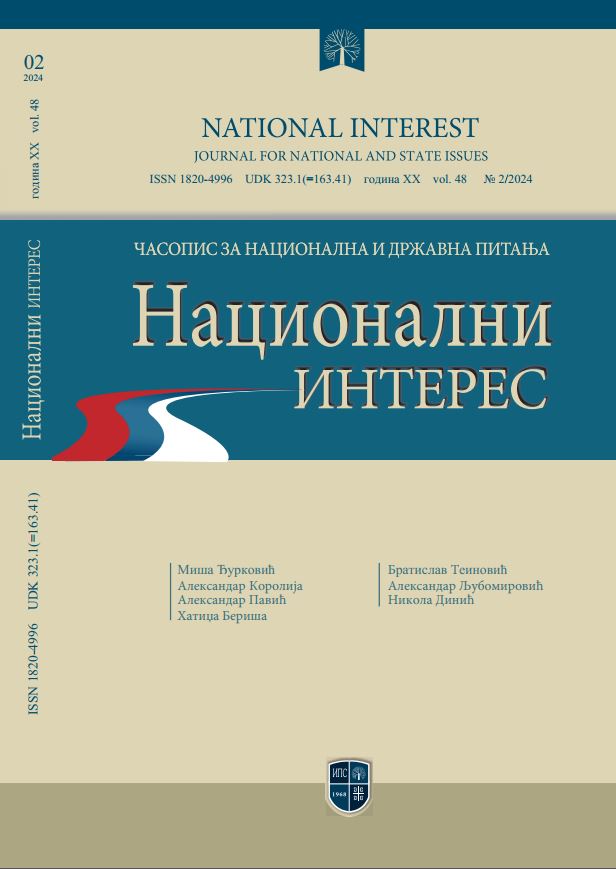ARTIFICIAL INTELLIGENCE AND NATIONAL SECURITY STRATEGY DEVELOPMENT - CHALLENGES AND PERSPECTIVES
Abstract
As a rule, the directions of development of the national security strategy are always aligned with vital national interests and modern achievements of society, which are imbued with modern challenges, risks and threats and available instruments of power. Monitoring global trends and the use of an adequate methodological approach enables the strategy to reflect a clear definition of national interests, ways of achieving them and the state's ability to achieve those interests using instruments of national power. Artificial intelligence through various forms of manifestation will significantly influence the development of future society. The implementation methodology will depend primarily on the needs and capabilities of the state. The goal of this work is to bring artificial intelligence closer to the professional public and to somehow place it in the focus of future considerations in the field of security and defense. Technology, which every day is becoming more and more present in all spheres of life, must find its role and place in strategic and doctrinal documents related to the defense of the state. Artificial intelligence must be integrated and operationalized as one of the starting points for creating a modern national security strategy, which is also the thesis of this expert work. The thesis clearly implies that the future national security strategy cannot be conceived without the concept of using artificial intelligence. The theoretical foundation of artificial intelligence is imbued in various scientific fields that primarily deal with automation and autonomous use of systems. Practical application found its basis in the gradual but comprehensive digitization of all spheres of life and society as a whole. From the point of view of national security, it is especially important to consider the impact in the development of autonomous weapon systems, the perspective of their use and the way they will shape modern armed conflicts.
References
Branković, Živojin. 2021. „[PARTNER 2021] VOJIN odnedavno sa najmodernijom opremom: Kako je domaćim snagama razvijen Sistem automatizacije centra Vazdušnog osmatranja, javljanja i navođenja – SA cVOJIN.“ TangoSix. https://tangosix.rs/2021/24/11/partner-2021-vojin-od-nedavno-sa-najmodernijom-opremom-kako-je-domacim-snagama-razvijen-sistem-automatizacije-centra-vazdusnog-osmatranja-javljanja-i-navodjenja-sa-cvojin/.
Čolić, Miro. 2022. „Komparativna analiza koncepta situacione svjesnosti i OODA pretlje“. Strategos, vol. 6, br. 2: 145-175. doi: https://hrcak.srce.hr/287952.
Čubura, Nikola. 1977. Kibernetika u rukovođenju razvojem oružanih snaga. Beograd: Vojnoizdavački zavod.
Milosavljević, Milan. 2015. Veštačka inteligencija. Beograd: Univerzitet Singidunum.
Dombrowski, Peter. 2015. “America’s Third Offset Strategy: New Military Technologies and Implications for the Asia Pacific. S. Rajaratnam School of International Studies. https://www.files.ethz.ch/isn/191706/PR150608Americas-Third-Offset-Strategy.pdf.
Government of the Republic of Serbia, Defense strategy of the Republic of Serbia 94/2019-4, December 27, 2019, https://www.mod.gov.rs/multimedia/file/staticki_sadrzaj/dokumenta/strategije/2021/Prilog4-StrategijaOdbraneRS-ENG.pdf, last accessed 14 October 2023.
Government of the Republic of Serbia, Resolution of the National Assembly on the protection of sovereignty, territorial integrity and constitutional order of the Republic of Serbia 125/2007-3, December 26, 2007, https://www.pravno-informacioni-sistem.rs/SlGlasnikPortal/eli/rep/sgrs/skupstina/rezolucija/2007/125/1/reg, last accessed 14 October 2023.
Government of the Republic of Serbia, Strategy for the Development of Artificial Intelligence in the Republic of Serbia for the period 2020-2025 96/2019-5, December 31, 2019, https://www.srbija.gov.rs/extfile/sr/437310/strategy_artificial_intelligence-condensed261219_2.docx, last accessed 17 October 2023.
Hammond, Grant T. 2001. The Mind of War, John Boyd and American Security. Washington DC: Smithsonian Books.
Hillner, Eric P. 2019. “The Third Offset Strategy and the Army modernization priorities”. Center for Army Lessons Learned. https://usacac.army.mil/sites/default/files/publications/17855.pdf.
Nowak, Edvard J. 2017. „The Aircraft Carrier’s Relevancy in Future Conflicts.” Master's Thesis. Marine Corps University Quantico: United States Marine Corps, Command and Staff College.
Osinga, Frans P.B. 2006. Science, Strategy and War: The Strategic Theory of John Boyd. Amsterdam: Routledge.
Podvig, Pavel. 2002. “History and the Current Status of the Russian Early-Warning System”. Science and Global Security, 10(1): 21-60.
Russell, Stuart, and Peter Norvig. 2010. Artificial Intelligence: A Modern Approach, Third Edition. London: Pearson Education.
Scharre, Paul. 2019. Army of None: Autonomous Weapons and the Future of War., New York: W. W. Norton & Company.
Sheikh, Haroon, Corien Prins and Erik Schrijvers. 2023. “AI as a System Technology.” In Mission AI. Cham: Research for Policy. Springer. https://doi.org/10.1007/978-3-031-21448-6_4.
Solomonoff, Raymond J. 1956. “An Inductive Inference Machine”. IRE Convention Record, Section on Information Theory. 56–62.
Taddeo, Mariarosaria and Alexander Blanchard. 2022. “A Comparative Analysis of the Definitions of Autonomous Weapons”. Sci Eng Ethics 28, 37. https://doi.org/10.1007/s11948-022-00392-3.
Tay, Shu Ing, Lee Te Chuan, A. H. Nor Aziati and Ahmad Nur Aizat AhmadAhmad. 2018. “An Overview of Industry 4.0: Definition, Components, and Government Initiatives”. Journal of Advanced Research in Dynamical and Control Systems, Vol. 10, 14-Special Issue, 10.
Turing, Alan M. 1950. “Computing machinery and intelligence”. Mind Vol. 59, No. 236: 433-460. doi: http://www.jstor.org/stable/2251299.
United Kingdom Ministry of Defense [UK MoD], Defence artificial intelligence strategy, June 15, 2022, https://assets.publishing.service.gov.uk/media/62a7543ee90e070396c9f7d2/Defence_Artificial_Intelligence_Strategy.pdf, last accessed 18 October 2023.
Wiener, Norbert. 1965. Cybernetics, Second Edition: or the Control and Communication in the Animal and the Machine. Massachusetts: The MIT Press.

